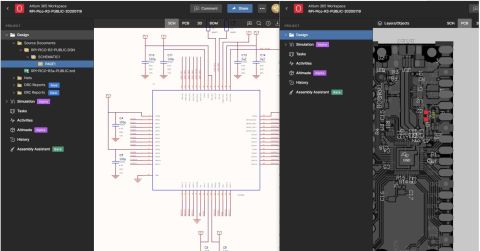Multi-CAD Engineering: Top 6 Challenges

In an ideal scenario, every engineer, manufacturer, contractor, and customer would utilize the same CAD system, simplifying collaboration efforts significantly. However, the reality of product design is far from this ideal. Various companies opt for different ECAD systems, requiring accommodating this as part of electronics product development.
Even within a single organization, it's common to find different departments or divisions employing distinct design software, regardless of their physical proximity. This diversity leads to many challenges, including errors, disorganization, inefficiencies, duplication of efforts, and financial losses. But why is this happening?
Reasons for Multi-CAD Environments
Legacy Designs
First, many organizations operate with a primary CAD tool but also retain a range of legacy designs created in multiple CAD systems. These older designs remain relevant, often requiring updates or modifications to align with real-world applications or ongoing projects. Over 51% of respondents in our recent webinar poll declare legacy projects are the reason for maintaining more than one ECAD tool.

Over 51% of respondents declare legacy projects are the reason for maintaining more than one ECAD tool.
Decentralized ECAD Tool Selection
Secondly, you may encounter organizations with decentralized teams, each granted the autonomy to select their CAD tools. This diversity often stems from past acquisitions, where newly integrated companies wish to maintain their established workflows and practices.
Additionally, specific teams may prefer using a particular CAD tool over the organization’s primary option due to familiarity, efficiency, or because they have developed custom integrations with other software and systems. Switching to a different CAD tool could mean losing these tailored solutions or facing significant hurdles in reconfiguring their workflows.
In fact, over 40% of those surveyed admit to using a secondary ECAD tool at least every month, with just slightly over 16% reporting exclusive reliance on a single ECAD tool.

Over 40% of respondents use a secondary ECAD tool at least every month, with only around 16% reporting exclusive reliance on a single ECAD tool.
Design Contractors and Manufacturers
Lastly, the role of design contractors and contract manufacturers cannot be overlooked. These external partners work across a spectrum of clients, necessitating proficiency in multiple CAD systems to meet client specifications, recommendations, and preferences.
Challenges of Multi-CAD Engineering
But understanding the reasons behind multi-CAD environments is just the beginning. These diverse systems significantly complicate cross-platform ECAD management and collaboration, and here’s why.
#1 File Incompatibility
Different CAD systems typically use their own unique data formats, leading to compatibility issues when sharing files across platforms. While many CAD tools offer file converters to adapt another system's file to their format, these converters aren’t flawless, especially for complex designs. The conversion process itself can lead to issues like data loss, corruption, or errors, which may seriously affect the design's integrity.
While most data may transfer adequately for simpler boards, engineers or designers still need to manually update, adjust, or tweak the converted files and fix the broken links. This additional step incurs extra time and costs. If the board isn’t expected to undergo frequent updates (because it’s already in production or made only for spare parts), the time and effort to convert and update old legacy files to the current CAD format might not be worth it. As a result, many organizations opt to keep multiple legacy files as they are.
#2 Non-Centralized Design Data Management
Managing design data across various ECAD tools also presents a challenge due to the diverse methodologies used. For example, while some may depend on file naming for version tracking, tools like Altium Designer integrated with Altium 365 employ a sophisticated version control and release management system. This variance in handling versions and revisions across different CAD systems can lead to confusion and the use of outdated or incorrect design versions.
Without a standardized approach to version control and data management, organizations often turn to temporary fixes, such as utilizing central network drives or publishing releases to their Product Lifecycle Management (PLM) systems. These solutions, although functional, are compromises that fall short of optimally managing the complexities of multiple ECAD formats. They provide a CAD-agnostic environment to some extent but don’t fully solve the challenges of cross-platform ECAD data management, underscoring the need for more comprehensive multi-CAD environment solutions.
#3 Increased IT Infrastructure and Cost
Maintaining compatibility with multiple CAD systems escalates IT infrastructure and support expenses. Organizations must invest substantial resources to acquire dedicated hardware and software licenses and provide technical support for each system.
Moreover, multiple ECAD formats necessitate specialized viewer software, each requiring its own license just to access design files. This adds extra complexity and increases the potential for error, especially when designs are updated or modified.
#4 Fragmented Feedback Loops
Another challenge is the inconsistency of feedback mechanisms and design review processes across different ECAD tools. While some teams may resort to PDF redlining, others might depend on more formal review meetings with detailed reports. Over 53% of poll respondents declare reliance on manual collaboration methods with other teams. This fragmentation can lead to feedback and actionable tasks being dispersed and potentially overlooked across various communication channels like emails, Slack messages, and notes. Using multiple ECAD file formats often isolates information in different systems, complicating efficient collaboration.

Over 53% of respondents rely on manual collaboration methods.
#5 Complicated BOM Analysis and Scrubbing
Also, BOM analysis and scrubbing processes are influenced. Different CAD file formats prevent the automatic consolidation of all the data. This fragmentation means there isn't a single, unified source of truth for BOMs and parts, leading teams to manually export data into a universally accessible format like Excel to bridge the gap between systems. This workaround, while practical on the surface, introduces additional steps into the workflow, increasing the risk of errors and miscommunications. Furthermore, the lack of a standardized review process can cause critical details to be overlooked or misinterpreted, potentially resulting in costly mistakes and production delays. One of the solutions here is Altium 365 BOM Portal, which offers a centralized platform for all BOMs and parts management.
#6 Increased Training and Skill Requirements
Finally, working in a Multi-CAD environment requires users to be skilled in multiple CAD systems. This increases the training needs and can lead to a steeper learning curve for new employees. Gaining competency in multiple CAD platforms demands not just familiarity with the basic functions but also an in-depth understanding of their unique features, workflows, and integration capabilities. This complexity hampers productivity and increases the resources an organization must allocate to training and development.
Is Smooth Cross-Platform ECAD Collaboration Possible?
With all the challenges we’ve addressed, you might question whether effective collaboration across multiple ECAD files is even possible. Especially given that the existing collaboration systems limit themselves to a single CAD tool, failing to support the diversity required in a mixed ECAD environment.
But worry not. The answer is yes.
For product development to be successful, individual companies and teams simply must be capable of collaborating using various heterogeneous systems. They must exchange information effectively and transfer knowledge through the different stages of the product development cycle. Thankfully, technological advancements are paving the way for improvements in this area.
A prime example is Altium 365, the first truly ECAD-agnostic product development platform. Altium 365 ECAD Connectors foster a collaborative design environment that accommodates heterogeneous ECAD file formats. This feature allows you to benefit from advanced collaboration, digital design review and markup, robust data management and version control, and improved supply chain management, regardless of the CAD tool you’re working in, be it OrCADⓇ* or any other software.
Learn More
Our engineering reality is a diverse ecosystem where various ECAD systems coexist, driven by legacy projects, decentralized tool selection, and the varied needs of design contractors and manufacturers. This complexity, while unavoidable, introduces significant challenges, but technological advancements, like Altium 365 Multi-CAD File Support, consistently break down the barriers to effective cross-platform ECAD collaboration. Learn more about bridging the gaps in your multi-CAD environment.
*OrCAD® is a federally registered trademark owned by Cadence Design Systems, Inc. All references to this trademark are for identification purposes only. Use of this trademark does not imply any connection, approval, or endorsement by Cadence Design Systems, Inc. Supported file formats
1. Schematic: ORCAD .dsn files
2. PCB:
- OrCAD .brd v17.2 files and onward
- OrCAD .alg, .MAX, .ALG files
3. Library files (.olb, .pad, etc) are not supported for visualization currently; we only store them, without any web visualization.





